Okinawa 沖縄県
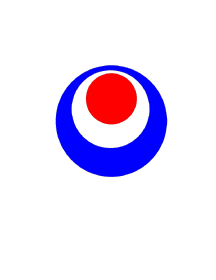

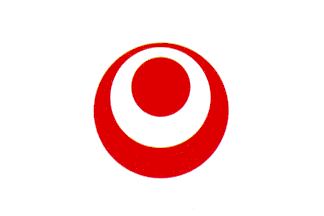
Okinawa Island (沖縄本島 Okinawa-hontō) is the largest of the Ryukyu Islands, and is home to Naha, the capital of Okinawa Prefecture. The island has an area of 1201.03 kmē.
During the American occupation of Japan, following the Imperial Japanese surrender after WW II, the United States controlled Okinawa Island, which remained under U.S. governance until 1972. Since then, United States Armed Forces personnel and Kadena Air Base have remained on Okinawa Island by invitation of the Japanese government as part of the Treaty of Mutual Cooperation and Security between the United States and Japan.
In 1990, the total population of Okinawa Island was an estimated 1.22 million people, comprising Ryūkyūans (especially native Okinawan's), Japanese people, and expatriates, as well as American military personnel and their families.
Whereas northern Okinawa Island is largely unpopulated, the south is markedly urbanized - particularly the city of Naha, and the urban corridor stretching from Okinawa City through Naha. The island also houses six gusuku, Okinawan fortresses most of which now lie in a state of ruin.
The southern end of the island consists of uplifted coral reef, whereas the northern half has proportionally more igneous rock. The easily-eroded limestone of the south has many caves, the most famous of which is Gyokusendo in Tamagusuku. An 850 m stretch is open to tourists.
The island's subtropical climate supports a dense northern forest and a rainy season occurring in late spring.
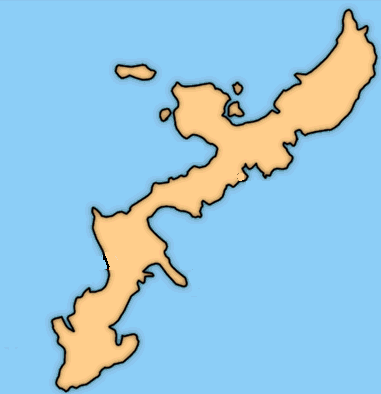
History
Following the end of World War II and the Battle of Okinawa in 1945, for 27 years Okinawa was under United States administration. During this time the US military established numerous bases on Okinawa Honto and elsewhere.
On May 15, 1972, Okinawa once again became part of Japan, although to this day the United States maintains a large military presence there. Over 15,000 Marines, in addition to contingents from the Navy, Army and Air Force, are stationed there. Representing only 0.6% of the total landmass of Japan, Okinawa supports roughly 75% of all U.S. troops in the country. Most Okinawan's feel that the large presence places an undue burden on their small island (20% of land on Okinawa Island is U.S. territory) and have been upset by a number of incidents involving U.S. service members and local citizens. Both Japan and the U.S., however, believe that the benefits of the U.S. presence outweigh the disadvantages. In 2006, the U.S. announced plans to move a few of its bases to Guam over a span of several years.
In Naha, some archaeological relics of
the Stone Age were found. Also, from a Jomon
period kaizuka, ancient Chinese coins were
found.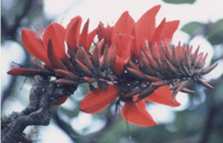
Today Naha has developed as a city around Shuri Castle, the palace of the Ryūkyū Kingdom. In the period of the Ryūkyū kingdom, there were five districts in the area of present-day Naha.
After the replacement of the Ryūkyū Kingdom with Naha Han in 1872, Naha became the capital city of Naha Han. Naha Han was abolished in 1879 and the former Ryūkyū Kingdom was once merged into Kagoshima prefecture. With the later establishment of Okinawa Prefecture, Naha became its capital city.
When Naha city was founded in 1921, in the area that present-day Naha occupies there were several municipalities including Naha city and Shuri city. Later Shuri was merged into Naha.
During the battle of Okinawa in World War II, attacks by US forces highly damaged Naha. The entire centre of the city had to be rebuilt.
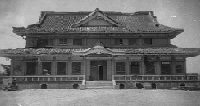
The is where Bushi Matsumura was commissioned as a body guard for the the king of Okinawa and where he spent most of his years in service. It's also where Itosu and Azato worked and were trained by Matsumura.
For 450 years from the beginning of the 15th century, it was the royal court and administrative centre of the Ryūkyūan Kingdom. It was the focal point of foreign trade, as well as the political, economical and cultural heart of the Ryūkyūs.
According to records, Shuri Castle burned
several times, and was reconstructed each time.
Before the war, it was designated a
National Treasure, but during the war, th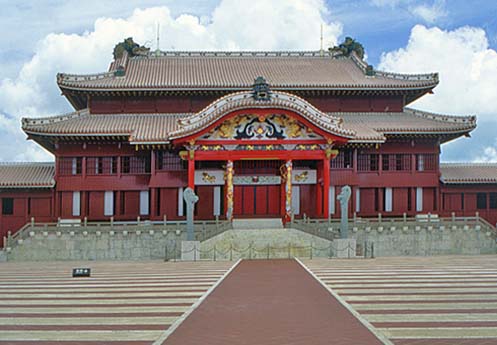 e
Japanese military set up its headquarters
underground at the castle, and beginning on May
25, 1945, the American battleship
Missouri and others shelled it for three
days. On
May 27 it burned.
e
Japanese military set up its headquarters
underground at the castle, and beginning on May
25, 1945, the American battleship
Missouri and others shelled it for three
days. On
May 27 it burned.
After the war, the
University of the Ryūkyūs moved to the
castle site. In 1958, the Shureimon gate was
rebuilt, and in 1992, the main building of the
castle was reconstructed. At present, the
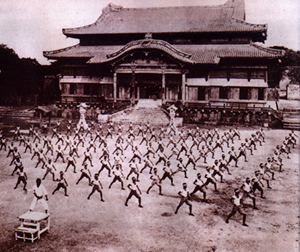 entire area around the castle
has been established as Shuri Castle Park. In
2000, along with other gusuku and related
sites, it was designated as a
UNESCOO
World Heritage Site.
entire area around the castle
has been established as Shuri Castle Park. In
2000, along with other gusuku and related
sites, it was designated as a
UNESCOO
World Heritage Site.